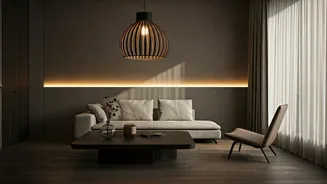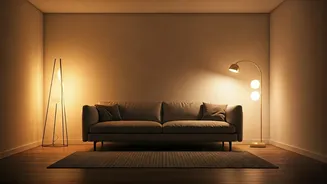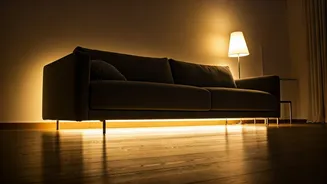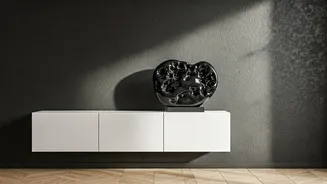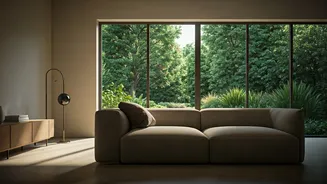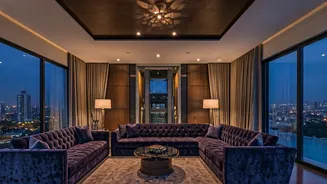Setting the Scene
Understanding mood lighting is fundamental to creating a welcoming and comfortable home environment. It's not just about illumination; it's about using
light to evoke specific feelings and set the desired atmosphere. The core idea involves manipulating the intensity, color, and direction of light to influence how a space feels and how it is perceived. Consider the function of each room. A kitchen, designed for tasks, might benefit from bright, functional lighting, while a bedroom needs soft, relaxing light to encourage relaxation. The possibilities extend beyond mere functionality to include the artistic potential of light. By carefully choosing light sources, light temperatures, and placement, homeowners can subtly change the character of a room. This approach to lighting design incorporates a layered approach to light, combining ambient, task, and accent lighting to achieve a harmonious and visually appealing result. Using different types of light and adjusting their characteristics becomes an important element in creating the desired atmosphere in the rooms, thereby personalizing your home.
Living Room Ambiance
The living room, typically a social hub, calls for a versatile lighting scheme that can accommodate different activities. When arranging the lighting in this space, think about layering different light sources, such as ambient, task, and accent lighting. Ambient lighting provides a general level of illumination, often from a chandelier or recessed lights. Task lighting, like a reading lamp, is crucial for specific activities. Accent lighting can highlight artwork or architectural features. Incorporating dimmers is essential for adjusting the light levels to the time of day, as well as the event being hosted. Consider using warm-toned bulbs to create a cozy and inviting environment for relaxation and conversation. For the living room, you can include floor lamps that direct the light upwards to create a wider light effect. It is important to remember to avoid harsh overhead lighting, as this can make the room feel impersonal. Strategic lighting will contribute to a more relaxed and welcoming environment for you and your guests.
Bedroom Lighting Design
The bedroom must be a sanctuary for relaxation and rest, so the lighting choices are key to creating a restful environment. It is crucial to aim for soft, warm lighting. This can be achieved through bedside lamps with shades, which provide diffused light. Consider the use of smart lighting, where you can adjust the light intensity and color temperature, and even set sleep timers. This will allow for a gradual dimming of lights as you prepare for sleep. Avoid bright overhead lights in the bedroom and opt instead for options such as wall sconces or recessed lights with dimmers. These can offer adequate illumination without being harsh. Layering the lighting is useful, and so you can combine bedside lamps with dimmable ceiling lights. You can create a peaceful atmosphere that supports your sleep. Moreover, the use of a salt lamp can provide a gentle, warm glow. This is helpful for setting a calm mood.
Kitchen Lighting Tips
The kitchen requires a blend of functionality and style, as it is a space for both cooking and gathering. The most important step for the kitchen lighting design is layering the light. This means incorporating ambient, task, and accent lighting to cater to different needs. Install overhead lights for overall illumination, under-cabinet lighting to illuminate work surfaces, and pendant lights over an island for a stylish touch. Task lighting is essential for areas like countertops and the stove. Consider using LED strip lights, or recessed lights, which provide ample light without being overwhelming. Ambient light, such as recessed lights, should be diffused across the room. Make sure that the light temperature is appropriate for the tasks in the kitchen. Avoid cool-toned lights, which can make the space feel sterile. Instead, choose warm, inviting light. Think about integrating dimmers to adjust the light levels according to the time of day and the activity. This flexibility ensures both functionality and ambiance in the kitchen.
Dining Room Lighting
The dining room is designed for dining and conversation, so its lighting should enhance both experiences. The key to effective dining room lighting is to create a warm and welcoming ambiance. Central to this is a pendant light or chandelier placed directly above the dining table. This light should be hung at a height that does not obstruct views or cause glare. The light should also be dimmable. This allows you to adjust the lighting according to the mood and occasion. Consider using warm-toned bulbs to create a cozy atmosphere. Accent lighting, such as wall sconces, can highlight artwork or architectural details and further enhance the room's character. Avoid harsh overhead lighting that can make the space feel impersonal. Adding a dimmer switch is another important element in lighting. It offers you complete control over the light’s intensity, changing it from a bright glow for entertaining to a soft light for an intimate dinner. Always remember that the dining room should feel welcoming and comfortable.
Bathroom Lighting Ideas
Bathrooms require a strategic blend of functionality and style, with lighting playing a key role in achieving both. The primary focus should be on adequate illumination for grooming and hygiene, with task lighting around the vanity being essential. Install lights on either side of the mirror or above it, to minimize shadows and provide even illumination. Consider LED vanity lights or sconces. Ensure the lights are moisture-resistant and safe for use in a bathroom environment. Incorporate ambient lighting, such as recessed lights or a ceiling fixture, to provide overall illumination. This is important for creating a balanced light distribution. Think about adding a dimmer to your main light source to regulate the light intensity. It is also a good idea to incorporate accent lighting, such as a backlit mirror, or to provide a touch of style and enhance the atmosphere. Warm-toned bulbs are recommended. They will give a relaxing and inviting mood.
Choosing Light Bulbs
The choice of light bulbs greatly influences the mood and efficiency of lighting within your home. There are various types available, including incandescent, fluorescent, and LED bulbs. Incandescent bulbs, though traditional, are energy-inefficient. They emit a warm light. Fluorescent bulbs are more energy-efficient and come in several color temperatures, but they can be slow to warm up and some people dislike the quality of their light. LED bulbs are the most energy-efficient and offer the widest variety of options. They are available in different color temperatures, from warm to cool, and offer a long lifespan. When selecting light bulbs, consider the color temperature, measured in Kelvin (K). Lower Kelvin values, such as 2700K, produce a warm, yellowish light. Higher values, such as 5000K, give a cooler, bluish light. For general lighting, warm white bulbs are most common. For task areas, select bright white bulbs for better visibility. Think about the brightness, which is measured in lumens. Make sure to get bulbs that are suited to your lighting needs.
Smart Lighting Systems
Smart lighting systems provide unprecedented control and flexibility. These systems allow homeowners to manage their lighting remotely, create custom lighting scenes, and integrate with other smart home devices. Many smart lighting systems use LEDs. These are designed with Wi-Fi or Bluetooth connectivity, letting you control them from a smartphone or tablet. The features offered are extensive. They include the ability to dim lights, change colors, and set schedules. Many offer voice control, allowing for hands-free operation via virtual assistants. Consider the cost-saving benefits of smart lighting. Many smart bulbs are energy-efficient and can reduce energy bills. Moreover, they can contribute to your home's security, through automated lighting features. Ensure that you have good network connectivity to avoid interruptions. With proper planning, a smart lighting system can dramatically improve your home's functionality, efficiency, and appeal.
